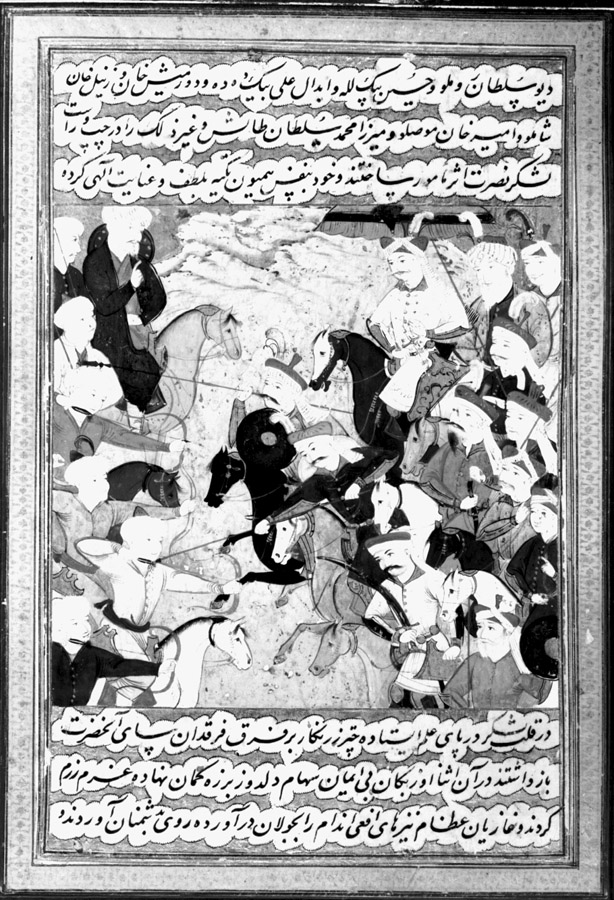Location: present whereabouts unknown
Mount: dimensions and color of mount and collar not known.
Written surface: 23.7 (estimated) x 15.2 cm.
Painting: 15.0 x 15.2 cm.
Text references: J.K., p.376 line 15 to p.377 line 4.
See also Savory, SA_1979, pp. 60-62 for this event in the History of Shah ʿĀbbās.
Date of this event: 916/2 December 1510.
While Esmāʿil was preoccuped with Arab Iraq, in Khorasan
Šāhibeg Khan took advantage of the situation, destroyed the remnants of the Timurid dynasty and brought under his control all of the territory from the borders of Persian Iraq to the farthest reaches of Turkestan. Then in 1509 Šāhibeg Khan made a plundering incursion into Kerman, well within Safavid territory. In response, in the summer of 916/1510 Esmāʿil mobilized his forces and marched toward Marv. The vanguard of the Safavid forces encountered Jān Vafā Mirzā, a relative of Šāhibeg Khan, outside the citadel walls of Marv; hard fighting reportedly took place and Jān Vafā retreated inside the walls of the citadel. Esmāʿil, not wanting to storm the citadel, devised a ruse to lure Šāhibeg Khan out from inside the walls. He feigned a retreat and marched away from Marv. Šāhibeg Khan, envisioned this as a sign of weakness, came out of the citadel, and pursued the Safavids. The Safavid rear guard gradually withdrew when the Uzbegs advanced, leading them into direct confrontation with the main Safavid force. A pitched battle took place in which the Uzbegs were decisively defeated. Šāhibeg Khan and Jān Vafā Mirzā were both killed as a result of the battle.
Moʿin conveys large groups of forces by massing seven to ten figures and their horses tightly together with their collective backs pressed against the outer frame of the painting. It is employed here twice, with the Safavid forces on the right, and the Uzbegs on the left (cf. also JK_088, JK_197 for similar). It is an effective device, communicates the mass without resorting to rendering huge numbers of individual participants as one finds in Ottoman painting. It also expresses the fundamental concept that the Iranians still consider battle as a contest of individuals, rather than faceless masses opposing each other as in modern warfare. Esmāʿil, under the umbrella of state, is on horseback at the top right, commanding his troops. What would seem to be Šāhibeg Khan is at the top left. The Safavids are advancing, the Uzbegs defending. Three lines of calligraphy above and three lines below theillustration. The painting is not signed.
Painting references:
Sothebys London, 4 April 1978 Lot 30
Robert Eng
Last Updated: September 25, 2012 | Originally published: September 25, 2012
